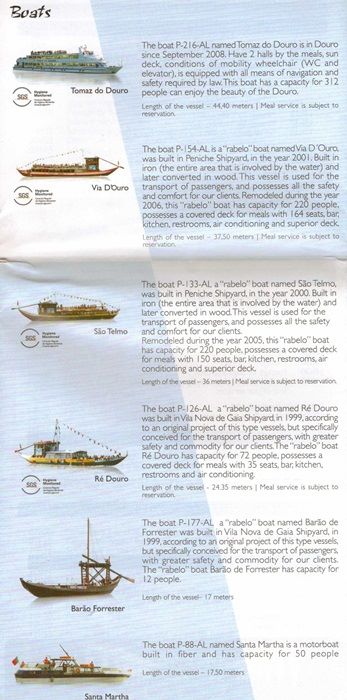|
OPORTO RIVER VESSELS page |
LUSO PAGES HOME PAGE
LISBON TRANSPORT
OPORTO TRANSPORT
Oporto Airport
Oporto Transport in Baedeker, 1898
Oporto's Bridges
Oporto Buses
Oporto (Gaia) Cable Car
Oporto Coaches
Oporto Excursions: Régua, Lamego
Oporto Funicular
Oporto Metro
Oporto Railways
Oporto Railway Trip to Coimbra
Oporto River Vessels
Oporto Tram Museum
Oporto Trams & Trolleybuses
Oporto Tram Routes Now
Oporto Transport Museum
Eating & Drinking in Oporto

Oporto - River Vessels & Shipping
 21 June 2015
21 June 2015
Above: Left; a "Rabelo" moored near the D. Luís bridge. Right; a Sandeman cruise vessel at the same location.
Oporto - River Cruises
In the late 1970s you would be lucky to see a passenger vessel of any size on the Douro at Oporto; the port-wine company of Ferreira did operate a small boat for tourists called the "Three Bridges Cruise", (nowadays it is a "Six Bridges Cruise", thanks to the three more recently constructed structures). The Ferreira cruises sailed from their premises in Gaia as far as the D. Maria Pia railway bridge to the east, via the double-deck Ponte D. Luís, and to the Arrábida bridge in the west - but that was about it.Now (2015), there are several companies running trips from both the Oporto (Cais Estiva) and the Gaia sides of the river, some of short duration and others going as far as Spain. The "Six Bridges" tour takes about 50 minutes and is an excellent introduction to the city.
Above: One of the larger boats that you will see at Oporto is the CroisiEurope 75-metre vessel "Fernão de Magalhães", built in 2003. It is seen here as it heads down river through Oporto in 2011 with what looks like a full complement of 142 passengers.

Right: The Tomaz do Douro fleet list.
Those offering river trips include:
There are invariably a number of the traditional "barco rabelo" type of boat, moored off the wine lodges on the quay at VN de Gaia and, less numerously, on the Oporto waterfront itself. Historically, such vessels brought the wine barrels down from the upper Douro where the grapes had grown and been processed. Typically a rabelo is up to 23 metres long and has a square sail and a long rudder pole. It normally required a crew of 6 or 7. The railways were the first major blow to the river trade down the Douro, followed by the hydro-electric dam programme of the 1960s which hindered access from the upper reaches of the Douro. Today it is motorised vessels which offer trips on the river, though these are often marketed as rabelos themselves.
The short cruises along the river at Oporto give excellent view of the quayside both at Oporto and Gaia as well as close-up perspectives of the six river crossings. See also the Régua page for more on Douro cruises.
Even today (2015) there is still a small shipyard on the Gaia waterfront near the Ferreira lodge and, back in the 1960s, medium-sized cargo vessels could still be seen, moored at Gaia or in the river, just off the quayside. Today, however, if you want to see merchant ships, you really need to travel along the coast to Leixões, which is Oporto's ocean-going harbour. This can easily be reached by the Metro service to Matosinhos. If you get off at Matosinhos Mercado station, you are adjacent to the bascule bridge, the fourth largest of its type in Europe, from where you can survey the Leixões port area.
The Port of Leixões also has a brand new passenger terminal and, as well as the passenger cruise ships which occasionally call, there are merchant line which will still convey passengers, such as the Grimaldi Line, many of whose container vessels have some limited passenger accommodation. The harbour can accommodate vessels up to 250 metres in length and with a draight of 9 metres. Tugs are available and the todal range is a maximum of 3.7 metres.
The lower reaches of the Douro have witnessed many shipwrecks over the years; the Museu do Vinho do Porto on the river front between the Alfandega and Massarelos has an extensive list as part of its exhibition. A reminder of this history was only too visible in the early 1980s when the bow of a wrecked merchant ship was clearly visible on the rocks at the Castelo do Queijo for several years, before being removed.
Matosinhos
Matosinhos will be a familiar name to many as often the can of Portuguese sardines that you buy in the supermarket will bear the canner's address as Matosinhos. The town sits on the coast at the mouth of the river Leça. Formally it could be reached by taking the attractive tram route 1 from Infante. You can still get as far as the Passeio Alegre on the tram today but thereafter it is a bus trip (route 500 etc) to complete the journey. Alternatively, the Metro do Porto now runs to Matosinhos albeit by a different route altogether, largely inland. The Matosinhos Mercado stop on the Metro is just round the corner from the former tram terminus.
At the end of the Mercado Metro platform are steps up to the bascule bridge which links the town with Leça on the other bank. The bridge allows views of the ships in the harbour at Leixões and can be opened, like Tower Bridge in London, to allow ships to pass through. If you cross the river and keep walking, you come to Leixões's small beach.
The beaches nearer to Porto at Matosinhos have recently been upgraded; the nearest Metro stop to that is Matosinhos Sul. There is a useful tourist information office on the Matosinhos beach at the town end. The town is the birthplace of the internationally renowned architect Alvaro Siza. There are also beaches between Matosinhos and Porto, at Foz.
Copyright: ©

Contact: the following is not a link; please transcribe the address into your email
